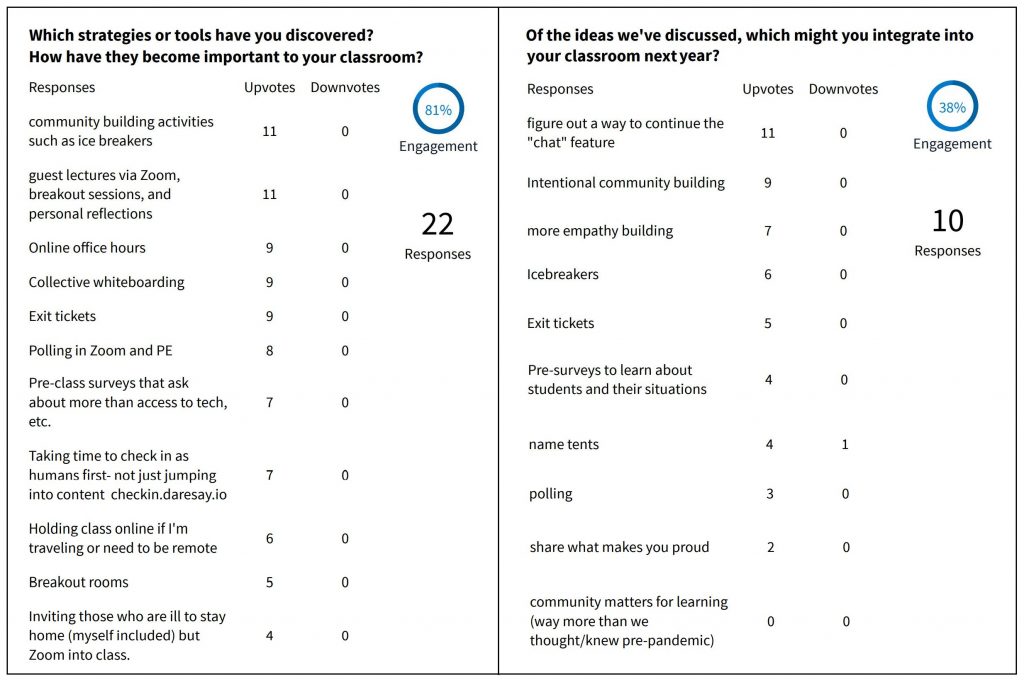Panelists: Alfredo Artiles, Victor Lee, Emily Levine, Taylor LiCausi, Emily Schell, Sanne Smith
Moderator: Karin Forssell, Director of Learning, Design, and Technology Master’s Program, GSE
Recordings of the session:
Central questions:
- In what way(s) did our classrooms evolve or shift throughout a year of remote instruction?
- Which strategies or tools ended up making a difference?
- How can we integrate what we’ve learned into instructional practices going forward?
Key quotes:
Lots of students like it when we go over code together but some students are really fast and some prefer to take more time…I was never able to do that really well before [the pandemic]…but now it’s nice because I can record it and offer it asynchronously…And students often go back to previous labs, and that has been really helpful for them. – Sanne Smith
I threw the whole kitchen sink at it. Every feature you could possibly imagine was in this course…And I hadn’t touched the other class…I book-ended a 90-minute session with two offline activities. The first was a podcast or some sort of listening and the second was a reflective journal…And I got hugely positive reviews about this [second] format and much more lukewarm reviews about the very feature-heavy class. – Emily Levine
What I loved about Canvas this year [was] really thinking about it both in terms of the modules…and how we can make it a student community that exists asynchronously. We really used the discussion forums…as an opportunity for students to post questions, ideas about assignments, and to give peer feedback. It helped us know what students were interested in and model how professors and students can have equal ownership over the learning community. – Emily Schell
[A community engaged learning component] opened a lot of opportunities for students to make the content relevant. I had a very diverse group of students not only in terms of demographic backgrounds, but also in terms of programs and disciplines. All of those to me were just incredible potential opportunities to enrich the experience. – Alfredo Artiles
Breakout rooms were a way into this intimacy and personalization. It didn’t require the same effort like coming to office hours or staying after class. As a result, we normalized vulnerability, which allowed for more personalized interaction and for more questions about the material to surface to ultimately improve understanding. – Taylor LiCausi
[The pandemic] tested a number of assumptions. For example, you might expect students to be able to print something out, but students don’t necessarily have printers in their rooms or their apartments. And, when they need to print something, they rely on the library which they may not be able to get to. – Victor Lee
Take-aways:
Which aspects of teaching have come to the fore?
- Giving students space for reflection (Emily Levine)
- Normalizing vulnerability, getting to know the students more, and exercising more empathy for students given our shared experience of the pandemic (Taylor LiCausi)
- Utilizing accessible links in Canvas and Zoom chat (Victor Lee)
- Community connection, enrichment, and engagement through diversity (Alfredo Artiles)
- Mindfully creating accessible material (Victor Lee)
What opportunities have emerged?
- Remote learning has opened the home, and students can bring their whole selves to class (Emilly Schell)
- Opportunity to get to know students individually during office hours (Alfredo Artiles)
- The choice of background can be its own icebreaker and lead to commonalities (Victor lee)
- Canvas has many features that were not utilized previously (Emily Schell)
What might instruction look like going forward?
- Preserving the Zoom chat in some way for varied methods of student expression (Victor Lee)
- Technology and electronics can be used to engage students during class with short activities (Alfredo Artiles)
- Guest speakers can virtually make an appearance in the classroom (Emily Levine)
- Asynchronous student community through Canvas discussions (Emily Schell)
- More openness to students using technology in the classroom (Sanne Smith)
- Small group discussions in the classroom to emulate breakout rooms (Taylor LiCausi)
- Using Poll Everywhere to get consistent and engaged feedback from the whole class (Sanne Smith)
- Student tent cards to remember preferred names and pronouns (Victor Lee)
- Mindfully designing your Canvas course (Emily Schell)

